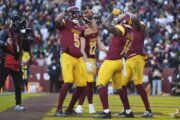WASHINGTON – Bike lanes are intended to give cyclists a clearly defined area in which to move. The painted lanes also indicate to drivers that they can expect to see bike traffic in the area.
In order to make sure cyclists can travel safely, some high-traffic areas are lined with barriers. On Pennsylvania Avenue, the D.C. Department of Transportation is piloting the use of “zebras” – black-and-white rubber barriers that rise from the street in half-circles a few inches high. The idea is to stop drivers from making illegal U-turns.
On the L Street cycle track in the downtown area, white flexible posts mark off the bike lanes. But cyclists say cars often ignore the barriers, sliding between the barriers and the curb, completely blocking the cycle track and often causing near-misses. Evan Wilder, a regular bike commuter, recorded one of his close calls in which a driver with New York license plates slides left, going from the driving lane right into the cycle track and directly into Wilder’s path. “It was just a slam-on-the-brakes situation, where if I hadn’t have done that, I would have gone right into the side of her car,” Wilder says.
It’s not Wilder’s first brush with what he calls “drivers behaving badly.” He’s made several videos of drivers on L Street and posted them on YouTube. Wilder’s been riding with a helmet cam for some time: In August 2011, when a truck driver shouted at him to move to the right, then clipped him, knocking him to the ground and driving off, the video was used to bring charges. The driver in that case, former D.C. police officer John Diehl, ended up pleading guilty to destruction of property and leaving the scene of a collision.
Wilder says he’s frustrated with how drivers seem oblivious to both the painted bike lane and the barriers that are intended to separate motor vehicle traffic from people on bikes. Gabe Klein, who left D.C.’s Department of Transportation to take the same job in Chicago, says there are a lot of ways to create bikeways in urban areas, and “the design is absolutely key.” Klein says “mixing zones” such as the ones at the L Street intersections where bikes and cars blend and have to negotiate right or left turns, can create conflicts. Klein, who is returning to the area to take up private ventures at the end of the month, says physical barriers are optimal when designing bike lanes.
But Wilder says the physical barriers the flexible posts provide don’t seem to deter drivers from zipping into the bike lane. Blogger and bike commuter Brian McEntee says he sees the same problem on the L Street cycle track. And he’s suggested a solution: Make the cycle track narrower.
“My thought is by narrowing it slightly, and moving things over,” McEntee says, “it will discourage drivers from using it in the way they’re using it now” as both a cut through and another parking place.
Is it possible that confusion leads to drivers shifting over into the bike lane? McEntee, author of the “Tales from the Sharrows” blog, finds that hard to swallow. “You know, I once counted. There are 76 no-parking or no-standing signs over the 10 blocks of the L Street cycle track. There’s nothing confusing; there are pictures of bikes on the ground. It’s very clearly labeled that it’s a bike lane.”
(Note: The driver has entered the bike lane at a point where there is a broken line that’s intended to allow drivers in and out of an entrance, it is not intended to allow them access to use the bike lane at that point. Further ahead, there is an area – a “mixing zone” where the driver can begin to enter the bike lane to make a left turn. The “mixing zone” is indicated by the broken painted lines. The driver made her move to the left well ahead of that “mixing zone” as the video shows.)
Wilder recorded this close call with the New York driver on You Tube:
Another recording captures “Dangers of the L Street Cycletrack” –
Follow @WTOP on Twitter.







